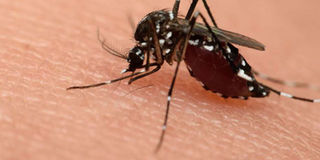Blood transfusion can spread malaria, say scientists

An Anopheles mosquito, which spreads malaria. FILE PHOTO
What you need to know:
- According to the World Health Organization, 90 per cent of all malaria cases are located in sub-Saharan Africa.
New malaria infections could be aided by blood transfusions, scientists have warned, emphasising on the need for higher screening standards to save patients.
In a new study, researchers from the Worldwide Antimalarial Resistance Network (WWARN) found that as many as 25 per cent of blood bank supplies in sub-Saharan Africa contain malaria parasites.
This could be a big risk as patients in need of more blood are often vulnerable to new infections.
In another study that focused on blood supply in Equatorial Guinea’s capital, Malabo, there were even higher levels of dormant malaria infection, as high as 89 per cent, but undetectable by common diagnostic tools.
CHILDREN
The scientists presented both results at the Multilateral Initiative on Malaria (MIM) Pan African Malaria Conference in Dakar, Senegal, early last week.
Sub-Saharan African countries like Kenya carry the highest burden of malaria in the world, making malaria the highest killer of children under five years.
According to the World Health Organization (WHO), 90 per cent of all malaria cases are located in the region.
In Kenya, WHO says 70 per cent of the estimated 46 million people are at risk of contracting malaria and 3,000 children under five die every year from the disease.
RESEARCH
Malaria prevalence is highest in Lake Victoria region, where one in three people gets infected, though preventive measures since 2010 have lowered the prevalence from 38 per cent.
To curb malaria, all sources of disease transmission, including the region’s blood banks, should to be addressed, the scientists advised.
The first study titled “A systematic review and meta-analysis of the risk of transfusion-transmitted malaria from blood donors in sub-Saharan Africa”, was conducted by Dr Selali Fiamanya and colleagues from WWARN.
They collected data from 24 studies to assess malaria prevalence among 22,508 blood donors.
BLOOD BANKS
They observed a pooled malaria prevalence of 23.46 per cent, with incidents ranging from as low as 6.5 per cent to as high as 74.1 per cent.
This meant that while the presence of malaria parasites varied in the blood samples across the board, almost a quarter of all blood banks were infected.
The study shows that children receiving transfusions to address anaemia caused by malaria could also be at risk of more exposure to malaria parasites. “Malaria is one of the primary infections that can be transmitted through blood transfusion in sub-Saharan Africa,” said Dr Fiamanya in a statement on Monday.




